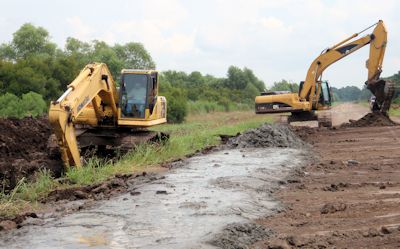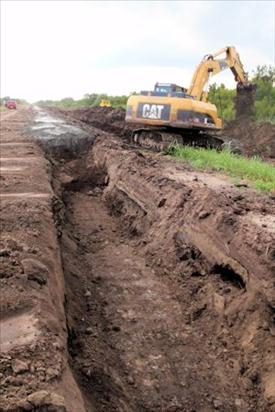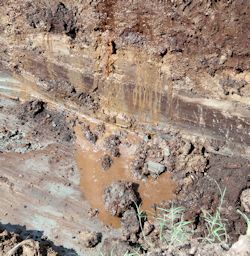ENGELHARD — Breezes were pungent with a smell of swampy dirt dug up by machinery at Mattamuskeet Ventures, a farmers’ partnership that is in the midst of a revolutionary hydrology project in Hyde County.
As onlookers stood nearby, the claw of the excavator stopped its work long enough to allow a peek deep into the ground. The earth was striated, with a slate-gray sandy loam on top and black organic material in layers beneath it. Water streamed from seams in the dark dirt, as if directed through small pipes. It flowed continually, spilling down the side of the dike.
Supporter Spotlight
 |
|
 |
Road coring in progress. Once the roads around the perimeter of the project are cored, water will not be able to seep out of restored wetlands and back into the association’s drainage network.
|
If anything illustrated the value of management of water on this vast farmland, it was this striking underground view of the natural hydrology of the land.
“When they open it, if there was water over there,” said Gene Fox, an environmental scientist employed by the partnership, pointing to wetlands behind the ditch, “you’d see water coming out of here like a fire hose.”
The first phase of construction of an ambitious hydraulic restoration project that will redirect millions of gallons of polluted farm field runoff away from estuarine waterways began recently within the 42,500-acre Mattamuskeet Drainage Association, which for about 30 years has managed stormwater through numerous canals that run to the Pamlico Sound, the Alligator River and the Intracoastal Waterway.
“You can see how the roads and the canal system creates a grid,” said Erin Fleckenstein, project administrator for the N.C. Coastal Federation. “And nature wasn’t gridded out like that.”
Supporter Spotlight
The federation is leading collaboration between farmers, N.C. State University, USDA Natural Resource Conservation Service, the U.S. Fish and Wildlife Service and several other state and federal nonprofits and agencies to restore 2,750 acres of wetlands and filter millions of gallons of stormwater runoff from two large Hyde County farms.
That’s quite an expansion of the federation’s initial goal 15 years ago to restore the oyster population.
“We originally got interested in working with the farmers because of the shellfish closures in Pamlico Sound,” Fleckenstein said during a recent visit to the project site. “It’s good for oysters, it’s good for water quality and it’s good for the farmers and what they need to do.”
By directing field runoff to restored wetlands, nutrients will be able to drop out of the retained water and be processed by vegetation. Any overflow would be able to seep into the land and channeled to flow off the farm.
“We’re trying to point this water in the same direction it would have been historically,” Fox said. “That would be mostly toward the north and west – the Alligator River.”
An excavator began in late July to core the first of the 14,000 feet of dikes — at a rate of about 500 feet a day — that will line the project’s perimeter. Ten swales and two sloughs that will direct the water flow through the wetlands will also be constructed, and the drainage water will be retained in one of three shallow areas adjacent to the farmland.
 Organic soils allow water to seep out of restored wetlands into the association’s drainage network unless properly cored. Organic soils allow water to seep out of restored wetlands into the association’s drainage network unless properly cored. |
The canals that crisscross the farm will be retrofitted with pumps and weirs that will redirect stormwater during heavy rains into the wetlands, rather than allowing it to discharge into the sound. The dikes will prevent the water from running back out from the wetlands.
Pumps in five pump houses on canals in different spots along the perimeter of the property are turned on as needed. Most of the time, the pumps are idle in the summer, when crops suck up rain, but they’d be activated during a tropical storm.
The end result when the project is completed next spring will be positive all around, Fleckenstein said. Farmers will have access to irrigation in the dry months and be able to manage excess water flow and limit saltwater intrusion that damages crops. Fish and aquatic life in the estuaries will be able to thrive in cleaner water. Wildlife will gain healthy habitat.
“Everybody is starting to look at projects that benefit the environment,” said Jamin Simmons, referring to the farming and fishing community.
Simmons is one of Mattamuskeet Ventures’ five partners, and his company is one of 42 landowners in the association.
Another property owner in the association, Wilson Daughtry, an owner of Alligator River Growers and Lux Farms, is also working with the federation on a similar project on his land.
Funding for the projects has been provided from a total of about $2.6 million in grants from the N.C. Clean Water Management Trust Fund, the Natural Resources Conservation Service Wetland Reserve Program and the Albemarle-Pamlico National Estuary Partnership. Additional funding was provided by matching state grants and in-kind work.
Although skeptics remain, Simmons said that more often than not, people who work with nature see the value in protecting nature. “When I put the group together to buy this farm, the common thread was wildlife,” he said. “The next common thread was the environment.”
Bumping along in his pickup truck down some of the 57 miles of roads through his farm, Simmons, a native of Hyde County, chatted amiably about his regard for conservation and the environment, frequently interrupting himself along the way to point out sightings of bear, deer and numerous quail.
 Jamin Simmons |
Simmons is no stranger to outdoor life. His family’s hunting and fishing guide service that his grandfather started was the among the first guide businesses in Hyde County, and he and wife recently started their own guide business, Dare to Hyde Outdoor Adventures.
He also is an owner of Mattamuskeet Management and Consulting, which had helped install the first wetlands restoration project in the country in 1992. The company also worked with numerous public agencies to develop the first system in North Carolina that recovered tail water, the water that is discharged from a pipe. Mattamuskeet Consulting partnered with N.C State in designing the current Hyde project.
A member of the Coastal Resources Commission for going on three years, Simmons lauded the federation’s way of getting divergent parties –farmers, environmentalists, regulatory agencies – to work together in creating innovative models that aim for the mutual good.
“They are being proactive and making the system work between different factions,” he said. “I really think the approach the Coastal Federation takes is the way to go. It’s a win-win situation.”
In 2010, Mattamuskeet Ventures had partnered with the federation on construction of a model hydrology management project that created 600-acres of shorebird habitat on the farmland. The project was one of the first collaborations in the region between farmers and conservationists.
“What has happened over the years is if somebody said ‘conservation,’ landowners would run from it,” Simmons said. “But most landowners want clean water. They’re not against the environment; they’re against regulation.”








